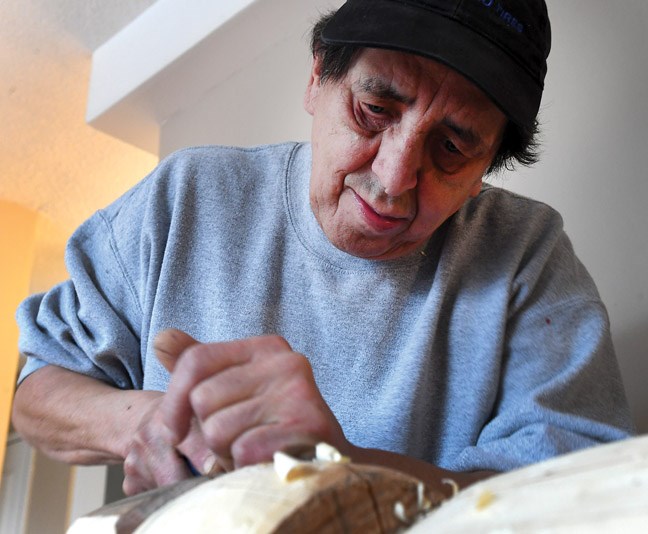To honour his murdered mother and those who face a similar fate across the globe, master carver Lenard Paquette Jackson, of the Cree Nation, is letting his work send out its message.
"I want to honour my mother who was murdered when I was two and a half years old and other women from around the world who have been murdered, terrorized, and beaten. It's time for us to stop that. Women should be treated with kindness and respect. They are the life givers."
Paquette Jackson has almost completed a totem which holds many images symbolizing hope, light and life including an eagle and its baby, a mother grizzly with her cub, a frog and a human.
Paquette Jackson's mother, Rita Alice Paquette, was murdered in Slave Lake, Alta. in 1956.
"That's the story I want to interpret into this totem pole," he said. "I never knew my mother and she needs to be remembered."
The artist will turn 65 on May 15 and looks forward to then being officially considered a First Nations elder. He has plans to share his culture proudly with the world, not only sharing his artistic talents by displaying his totem poles, drums and masks but also preparing full dance regalia so he can perform at events around the country.
"Elders are our most important commodity in the world," he said.
"Elders really hold their presence about them and should be respected."
Paquette Jackson is seeking sponsorship that would allow him to showcase the many facets of his talent.
Paquette Jackson creates small drums to share part of his culture with the community.
"The little drums are used for healing purposes and long ago the medicine man might have used them," he said, shaking one of three small drums like a rattle.
"It's important to have rhythm because that's what art is, it's rhythm and motion."
He picks up another rattling drum in demonstration and offers more information.
"A shaman might bring a rattle to your home so he can shake out the evil," he said. "Evil can come in many forms, it can come in the form of a beautiful woman, it can come in the form of a really nice dog, same with a man."
Paquette Jackson finds a beat with a little drum and sings a spontaneous song about the creator.
"I was singing to the creator, to honour the creator because he's the only one," he said. "He blessed me with this beautiful gift I have and it's not a selfish gift, it's a very humbling gratitude gift."
Paquette Jackson grasps a copper sculpture and raises it up to the light.
Copper ornaments symbolize wealth and high ranking and some people hang them on the wall while others will use them as ornamental jewelry and wear them around their necks, Paquette Jackson said.
He spends time in the Two Rivers Gallery where he's carving a commissioned wooden sculpture he's in the Maker Lab. Beside that space is the open area called the Atrium where all the children's classes and school programs take place.
Paquette Jackson spends much of his time there guiding children who come to the Two Rivers Gallery.
"I don't know what it is but I have this incredible ability to draw the children to me," he said.
"They just want to learn and they are so creative. In the 1950s and 1960s native people never had the opportunity to share their knowledge but now we're accepted more and we must educate the children and introduce them to all cultures of people."
Paquette Jackson's sun mask temporarily rests within the walls of the Canfor gallery at Two Rivers.
It's part of an exhibit which marks the 150th Anniversary of Confederation of Canada. The exhibit features work from artists from throughout the province.
The sun mask ultimately symbolizes Kukum, which means grandmother.
"Everybody knows who grandmother is," he said. "She just wants to love everyone. This is the soul character of everything living on the Earth."
The rays of the sun symbolizes clans of the area, beaver, bear, frog, grouse and caribou, he added.
"Since the beginning of time our elders have told stories of our history through the life cycle of neso, which means two," he said.
"Everything comes in two, woman, man - life giver and provider, animals, birds, ants, everything."
The sun mask is wrought with symbolism that encompasses man and nature, the creator and how the universe comes together.
Paquette Jackson wants the opportunity to share his knowledge with as many people as he can.
"Passing along as much of our culture is so important," he said.
"It's something that should never be lost."



.png;w=120;h=80;mode=crop)